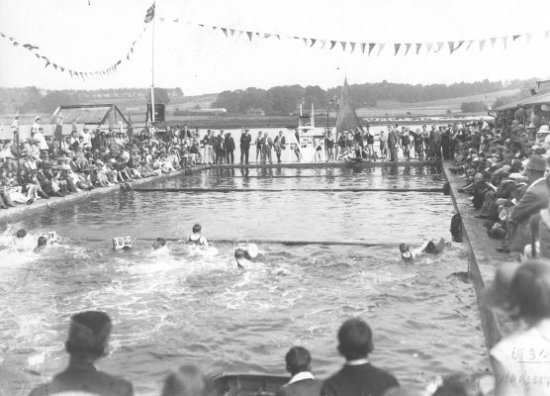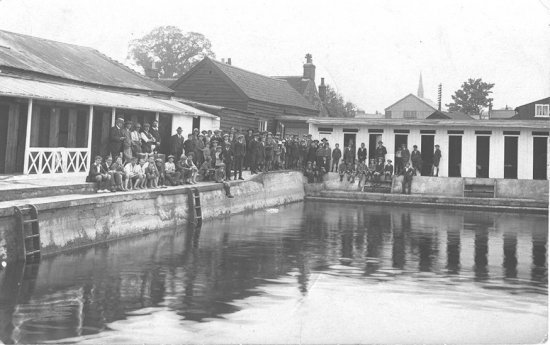Old, and Some New, Photographs of Woodbridge & Melton
From the junction of Sun Lane with the Thoroughfare, there used to be a road, called the Old Kings Highway. It went to a common, by what is now Lime Kiln Quay, to the bottom of what is now Brook Street. From there the road went along what is now Quayside and Station Road to joined up with the road to Ipswich. Eventually all traces of the riverside link between the bottom of Brook Street and the what is now Sun Lane were lost. All that remained was a footpath beside the marshes and saltings.
Phineas Pett, who became master shipwright of Deptford in 1599, often lodged at the Crown Inn in Woodbridge while on timber buying expeditions in Suffolk. On one such visit in 1633 he realized that it would be easier to build men-of-war in Woodbridge rather than transport ungainly logs to other shipyards. He also saw a means whereby this could benefit his family. He arranged for his son Peter to may the daughter of Thomas Cole, the proprietor of the Crown Inn, who had become Lord of the manor of Woodbridge Ufford in 1632. By this marriage Peter Pett acquired property in the town, including a shipyard at Lime Kiln Quay, and he eventually inherited the manor of Woodbridge Ufford.
Phineas and Peter Pett were able to direct some contracts for the building of 4th rate men-of-war to the Woodbridge shipwrights Thomas Adams, Edmund Mundy and William Carey. Between 1625 and 1638, eleven ships of substantial size were built including the largest of them all, the Levant Merchant of 400 tons. Fifty years later vessels of 600 tons were under construction.
Most of these vessels were probably built at Lime Kiln Quay where the channel cuts into the bank making it the best place to launch ships. However the Suffolk Traveller of 1730 also mentions "another dock below the Common Quay, where the Kingfisher man-of-war was built, but this is now cut off from the river by a mud wall". This dock was probably the Lord's Quay which was at the end of what is now called The Avenue.
It is not known how many people in Woodbridge were involved in the ship building trade at this time, but it must have been considerable because every piece of timber had to be fashioned by hand. Woodbridge's future as a shipbuilding centre was, however, not assured. the town had no dry docks and ships were built on slipways and launched at high tides. The narrowness of the river would have also made the launching of large ships difficult.
George Arnott suggests that the building of men-of war at Woodbridge reached its peak in about 1660. After that a gradual decline set in, perhaps because timber was getting scarce or, more likely, because the Thames-side yards were expanding rapidly and were capable of building much larger ships. Also, in 1667, the Woodbridge yards lost the patronage of Peter Pett. His career ended suddenly when the Dutch raided the British fleet at Chatham and captured the flagship the Royal Charles. Pett was blamed for not ensuring that the dockyards were adequately defended. He was impeached by the House of Commons and was eventually dismissed.
The 18th century is something of a blank as far as Woodbridge's shipbuilding history is concerned; few records of that time have survived. The only shipyard was on Lime-Kiln Quay and this covered the strip of ground running from the Deben right up to the Thoroughfare.
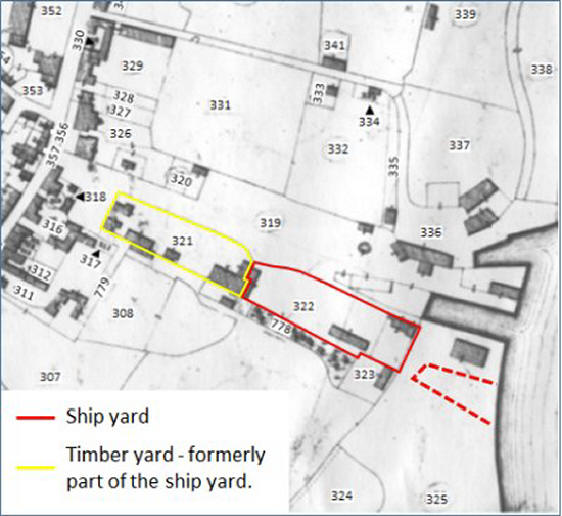
Map of the Lime Kiln Quay shipyard in 1838.
Samuel Turner took over the Lime-Kiln Quay yard when Edward Darley went bankrupt in 1751. He himself went bankrupt after building a 250 ton ship for the Jamaica trade in 1764. The next builder of note to operate from this quay was William Dryden who took it over in 1796. He mainly built ships for the coastal trade.
For the first half of the 19th century a steady stream of tubby little brigs and schooners were built at Woodbridge. (Cooper states that 25 brigs and schooners were built between 1816 and 1843.) The brigs went out of use in the early part of the century when they were replaced by the faster and more commodious schooners. The last of the Woodbridge brigs to be built in the local yards was the 117 tons Louisa in 1816. From then on the yards produced a succession of the faster and more commodious schooners.
In 1829 the Lime Kiln Yard was advertised for let as follows: "The premises comprise a commodious dock, enclosed building yard, ship warehouse and draft room, wharf, timber-yard, steam plank work shops, counting house, and well adapted convenience for conducting the ship-building business; together with a newly erected commodious dwelling house, situated at the entrance to the yard, commanding a view of the whole business.”
In November 1830 William Taylor took over the shipyard and eight years later it is clearly shown on 1838 map. An annotated extract from this map is shown on the right. The area outlined in red was being used as the shipyard and the area outlined in yellow, which was at one time part of the shipyard, was being used by a timber importer. The red dotted line marks an indent, shown on an earlier map, which was probably a slipway.
Among the schooners built by William Taylor was the Bernard Barton which was launched in 1840. Her voyages appear to have been between Liverpool and her home port, presumably carrying oil cake. The Ellen, a small schooner of 55 tons, was probably the last of these vessels to be Woodbridge built.
In 1850 the Lime Kiln Quay shipyard was advertised to let but there were no takers. When the East Suffolk Railway started to plan their service to Woodbridge in 1853 the shipyard was still vacant. They bought it in 1856 and four years later they had laid the main up and down lines and a goods line through the old shipyard.
The road between Quayside and Lime Kiln Quay was not re-established until 1976.
In 1850 the Lime Kiln Quay shipyard was advertised to let but there were no takers. When the East Suffolk Railway started to plan their service to Woodbridge in 1853 the shipyard was still vacant. They bought it in 1856 and four years later they had laid the main up and down lines and a goods line through the old shipyard. The impact of the railway is clearly shown on the right by overlaying the railway lines on an extract from the 1838 tithe map.
The railway lines superimposed on
1838 map of Lime Kiln Quay
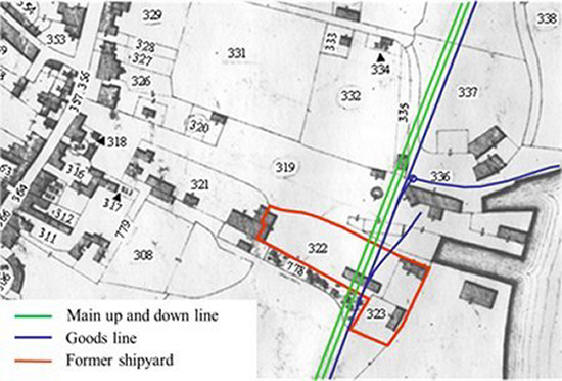
In 1856 the East Suffolk Railway finished laying the main up and down lines and a goods line through the former shipyard. There was, however, a level crossing which linked Lime Kiln Quay to a passage way which went up to the Thoroughfare. This this passage way is shaded light brown on the extract from the 1881 map shown on the right.
Shipbuilding at near Lime Kiln Quay could not, however, be killed off. This extract from the 1881 Ordnance Survey map shows that a new shipyard had been constructed on the water front just below the old shipyard. The new shipyard yard was probably the inspiration of the boat builder William Garrard in about 1860. It was taken over by Ebenezer Robinson in 1884 He laid the foundations for Woodbridge's yacht building industry and Ebenezer's son, A V 'Robie’ Robertson, gradually expanded the business.
Extract from the 1881 OS map. The passage way
which link the Thoroughfare to the level crossing
by Lime Kiln Quay is shaded light brown.
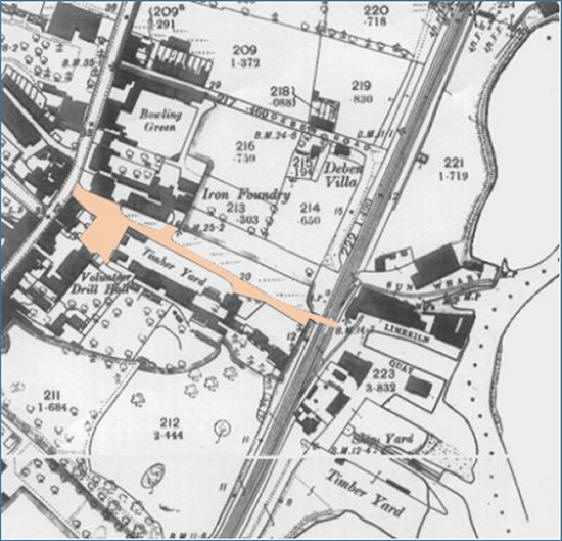
Between Lime Kiln Quay and the new ship yard there was another dock which appeared on the 1881 OS map but not on the 1844 Tithe map. It is also shown on the 1904 OS map. On the 1927 map it is called a Swimming Bath. Robert Simper says that the Mr & Mrs Robinson had the pool dug between their bungalow and the river in about 1910 but he does not mention the earlier dock on this site. Given the evidence for the earlier dock it is more likely that the Robinson had mud dug out of it to make it more suitable for a swimming pool. Simper also says that the pool closed in 1940 after it was claimed that some solders picked up an illness there.
